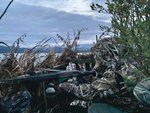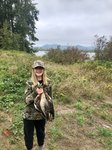

Kaylynn McSmith spent plenty of time in a hunting blind with her father growing up, but until this season she didn’t have the opportunity to shoot. The local hunting community helped change that.
Born without her lower left arm, 13-year-old Kaylynn wanted to go goose and duck hunting with her father, but Jon McSmith said he couldn’t figure out a way for her to safely handle a shotgun.
Millard Houser with Delta Waterfowl Columbia River Chapter and Adam Teig with SlapShot USA came up with a way.
“There’s just nothing out there until Millard and Adam started brainstorming,” Jon McSmith said. “I’d been thinking about it for 13 years and they came up with an awesome solution.”
The solution could help many others, too, as there aren’t many options on the market for firearm attachments, the family said. While Kaylynn can use a hunting rifle on a tripod, and got a deer last year, the same system wasn’t possible for hunting fowl.
“It was cool to see how supportive people can be of different things they don’t see every day,” Kaylynn said of the experience.
A Chance Encounter
Jon and Kaylynn met Houser at the Delta Waterfowl booth at this year’s Pacific Northwest Sportsmen’s Show, when Houser asked if she would be interested in an Oregon youth duck hunt. Houser told the pair about how he had put a pistol grip on a shotgun as a solution for one of his own injuries and offered to do the same for Kaylynn. Then, he started talking with Teig and a grander plan formed.
The end result was a customized Mossberg SA20, a semi-automatic 20-gauge shotgun, with a 28-inch bird barrel on it. Teig, an engineer, crafted a metal ball that attaches to the firearm with a three-dimensional printed plate.
The ball slots into a 3D-printed cup that attaches to Kaylynn’s existing arm prosthetic. Magnets in the cup keep the shotgun secure and give her full range of motion for tracking.
Teig and Houser also decided to switch out the standard stock for a recoil stock, which is a stock that compresses when the gun fires to absorb the kick. That makes it easier for Kaylynn to use.
“She’ll be able to have this thing her whole life,” Teig said. “The stock is extendable. It will grow with her.”
After seven months of testing, Kaylynn did go on the Oregon youth duck hunt in September. Teig said he wanted her to get “just one duck;” she brought home seven.
“I got four ducks the first day and five the next day,” Kaylynn said. “It was really fun and exciting.”
For her father, “it’s pretty wild to see her hold it up and swing it all on her own,” he said. Houser, who also attended the hunt, said the moment was an emotional one.
“It was just so exciting,” Houser said. “His little girl was out there for the first time. And now they could do it together.”
Community Coming Together
While Houser and Teig took the lead on creating prototypes, finding the right shotgun and helping Kaylynn test each iteration, both emphasized it was a community effort.
“The gun community around here, everyone wants to help each other,” Teig said. “We all love having our kids go out and go hunting and fishing.”
He said when the community heard “there’s a young girl that wants to go out and go duck hunting with her dad, but they can’t find anyone that can make her a gun or help her in a way that make it so she can shoot, it’s just like well, why don’t we just do it?”
Houser helped find the right firearm, while Teig started designing. Word spread, and others asked to get involved.
For easier carrying, Ron Cryderman with Bearpa Leatherworks made Kaylynn a leather sling with her name stamped into it. Matt Gray from Matty G Custom Guns cerakoted the gun with a color scheme Kaylynn picked and did custom engraving. KUKN donated radio ads asking for donations, and Mary’s Bar and Grill and Lumber Liquidators made large donations, Houser said. MoonLightin Outdoors, which is based in the Midwest, saw the effort on Facebook and also donated.
While Houser and Delta Waterfowl fundraised to cover the cost of the gun, Houser said he also intended to pay for people’s time and work, but nobody would accept payment. Instead, they set up a college scholarship for Kaylynn with the remaining money.
The Process
Teig said he started out with the idea of a magnetic attachment for Kaylynn’s prosthetic that would allow her to support the gun. While she already had an attachment meant for rifle hunting, the different shape of the shotgun wouldn’t work with it.
Houser said he took one look at the first prototype and knew it wouldn’t work. Even though it functioned, with rounds of magnets that turned on and off with a twist, it was just too big.
After playing with a similar design for months, in August Teig and Houser had a breakthrough. Houser used a magnetic phone holder in his truck, and Teig ran with the idea of a metal ball and magnetic cup.
It still took trial and error. The first try used a scoop-style cup that worked in theory, but when they went out to test it, the ball got stuck in the groove.
“We ended up going to a full cup,” Teig said, that gives Kaylynn “a crazy amount of motion.”
Teig spent all summer designing the different attachments and using the shop’s 3D printer to make them come to life, but “the first time she shot, that made every second of it worth it.”
The family was in SlapShot USA every week trying a new prototype in an “incredible process,” Jon McSmith said.
Throughout it, Sarah McSmith said her daughter diligently built up strength in her left arm by swinging the shotgun up and holding it so she would be ready.
Houser said they also tossed around the idea of electromagnetics, but that would require Kaylynn to carry a battery pack, and hunters in Washington cannot have anything electronic on their guns.
While the electromagnetics could potentially be allowed under ADA accommodations, Teig said they didn’t want there to be a need for special paperwork.
“We just want her to be able to do it,” he said.
Expanding Possibilities
The adaption for Kaylynn “opens up this window to help more people,” Houser said. He and Teig have reached out to other adaptive sportsmen groups to offer the attachment, as the ball and cup style isn’t limited to shotguns. It could be transferred to any gun, or even a fishing pole.
And now that Teig has the design, the initial cost is “pennies” — but he has no plans to profit from the invention.
“We all love Kaylynn, and I barely know her,” Teig said. “She’s changed how I do things. I’m hoping we can make some more of these and get a few more people out there.”
Sarah McSmith said most prosthetic attachments are expensive and single-function, and there’s very few meant for firearms. Jon McSmith added that “to find someone who has shotgun knowledge and knows what won’t cause safety issues, that’s not something you can go to a prosthetist for.”
Both said they appreciated how much SlapShot USA had done, and “from here on out, any of our gun needs, we’ll go through Adam,” Sarah McSmith said.
Teig is just as excited to keep helping Kaylynn, and Houser said everyone who’s worked with her has respect and admiration for the “ambitious” teen.
“She is going wherever she wants. She couldn’t shoot out of a duck blind, and that’s one place she wanted to go, so we made it happen,” Houser said. “I cannot express enough how gratifying and special it was.”
As for Kaylynn, goose season is coming up. Instead of sitting in the blind and watching her dad, she’ll be ready to participate.
“I want to go as many weekends as I can,” she said. “I love it.”